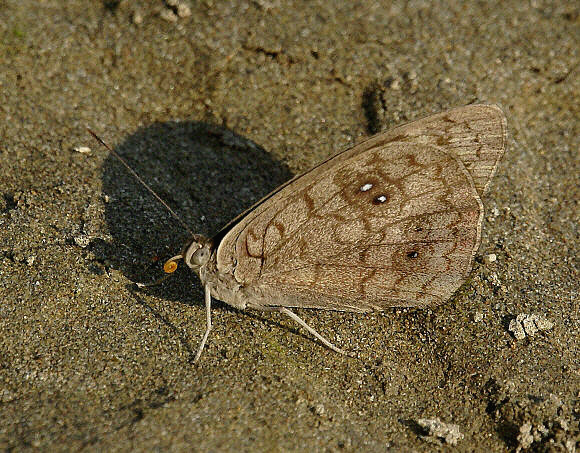 Eunica clytia, male, Rio Madre de Dios, Peru – Adrian Hoskins
Eunica clytia, male, Rio Madre de Dios, Peru – Adrian Hoskins
Introduction
The genus Eunica contains 40 species colloquially known as Purplewings due to the dazzling purple or metallic blue iridescence on the uppersides of the males. Females lack the iridescence, and are typically a dull earthy brown colour with a diagonal white band across the forewings. The underside hindwings of most species are beautifully marbled, and bear a distinctive arrangement of ocelli.
Eunica clytia is one of the less colourful species. Males are blackish-brown on the upperside with a vague purple sheen. The female is earthy brown above, with 5 very prominent white spots in the subapical area.
The butterfly occurs in the south-west Amazonian areas of Brazil and Peru.
Habitats
This is a lowland rainforest species found at altitudes between about 100-500m.
Lifecycle
The lifecycle of Eunica species in general is poorly known and I can find no published details of the early stages of this species. The eggs of most Eunica species are laid singly on the flowers and leaf buds of trees including Mabea ( Euphorbiaceae ) and Bursera ( Burseraceea ). The larvae are likely to vary considerably in colouration and pattern from species to species, but generally have short spines along the sides, and a single row of longer erect spines on the last 3 segments of the body.
Adult behaviour
Females are normally encountered singly, flying in light gaps in the forest understorey or basking on bushes along forest trails. Males however are usually encountered in mud-puddling swarms on river beaches in full sunshine.
It is worth recalling my observations of mud-puddling butterflies seen on a particular sandbank on the Rio Madre de Dios, Peru, in August 2007 :
On the day I arrived, recent rainfall had left the sandbank damp. Species including Panacea prola, Phoebis agarithe, Dryas iulia, Philaethria dido, Protographium agesilaus and Melete lycimnia were present in large numbers, formed into compact single species groups scattered along a stretch of about 50 metres. Other butterflies including Adelpha jordani, Lasaia agesilas, Baeotus deucalion, Marpesia furcula and Eunica clytia were only present in one’s and two’s. As the sand dried out over the next 4 days the species composition changed remarkably. First to disappear were the Phoebis, followed by the Protographium. New arrivals not seen previously included the skippers Antigonus nearchus, Camptopleura theramenes and Myrinia myris. Numbers of Eunica clytia increased daily. By the 4th day the sandbank was seething with a swarm of at least 500 clytia males, aggressively competing for space. All other butterfly species had abandoned the site, either because the sand had become too dry, or because they had been ousted by the swarming clytia. In the space of 4 days the scene on the riverbank had changed from a multicoloured patchwork of mixed species, into a swirling brown mass of Eunica clytia. A massive storm hit the area the next day so further observations were impossible, but my impression was that a migrating swarm of clytia had passed through, and that their migration had been triggered by the approaching storm.
